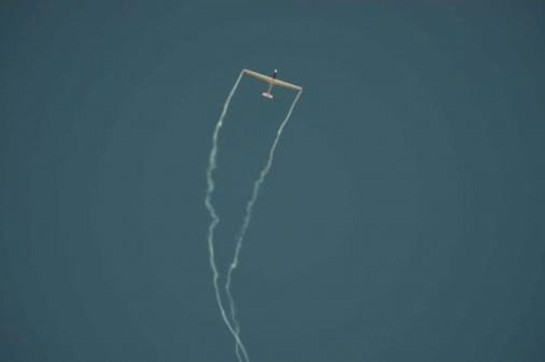
Athens Aviation Week 2018
Greek F-16C Block 30 fighter maneuvering during a simulated dogfight against a Mirage 2000EGM fighter.
For the third year in a row, the seventh air week was organized in Tanagra, where the Dassault Mirage 2000 fighters of the Hellenic Air Force are deployed, opening the gates to everyone. George Caravantos, a member of the organizing committee for Athens Aviation Week, was able to reserve a favorable spot to take photos and watch the show, making this report possible.
Since 2016, the air shows within the framework of the Athens Aviation Week have been moved to Tanagra Airport, where it is easier to get to those who want to see them. There is also a lot of space for spectators, and you can also watch takeoffs, landings and taxiing up close. The latter are especially attractive to aerobatic teams that circle in formation, sometimes with smoke. You can look at this very carefully.
Naturally, the largest number of planes and helicopters of the Greek Air Force participated in the demonstrations. The aerobatics of the Greek military aviation on the Lockheed Martin F-16 Zeus multirole fighter and the pilot of the Beechcraft T-6A Texan II Daedalus aerobatic team were especially beautiful. The first took off on Sunday in a group on a Boeing 737-800 communication jet in Blue Air colors, the second on Saturday with an Olympic Air ATR-42 turboprop regional jet.
Even more interesting was a simulated dogfight between a Μirage 2000EGM fighter from the 332nd Greek Air Force Squadron based in Tanagra and an F-16C Block 30 fighter from the 330th Squadron based in Volos, conducted over the center of the airport at low altitude. . On Sunday, both of these aircraft flew at low altitude in formation, linking up with Aegean Airlines' Airbus A320.
Two other McDonnell Douglas F-4E PI-2000 AUP fighter-bombers in special colors, belonging to the 388th Greek Air Force Squadron from the Andravida base, carried out a simulated attack on the Tanagra airfield. Prior to this simulated attack, both aircraft flew over Tanagra at very low altitude.
The next Hellenic Air Force aircraft on display was the Pegasus show group's Boeing (McDonnell Douglas) AH-64 Apache attack helicopter, followed by the Boeing CH-47 Chinook heavy transport helicopter. Especially this first show was especially dynamic and impressive, perfectly demonstrating the maneuverability of the AH-64 Apache helicopter, which is very important on the modern battlefield.
In turn, the aviation of the Greek Land Forces showed a parachute landing blown up from a CH-47 Chinook helicopter. Another type of landing - on ropes descended from a helicopter - was demonstrated by a group of special forces of the Greek Navy, landing from a sea helicopter Sikorsky S-70 Aegean Hawk. The last helicopter shown was an Airbus Helicopters Super Puma performing a simulated combat air rescue operation.
Another major participant was a Canadair CL-415 firefighting seaplane, which made an elaborate attempt to lower temperatures at Tanagra airport by dropping water bombs on both weekends.
Exhibitors at the jet combat aviation exhibition included Belgian Air Force F-16s, part of the new Dark Falcon demonstration group. Belgium always participates in the Athens Aviation Week demonstrations and the assembled public always marvels at the display of the Belgian F-16s.
The big surprise of this year's Athens Aviation Week was the presence of not one, but two McDonnell Douglas F/A-18 Hornet multirole fighters, one each from the Swiss and Spanish air forces. Aircraft of this type are not present at all exhibitions, and they were present at the Athens Aviation Week for the first time. Both teams delighted the spectators by demonstrating the excellent maneuverability of their fighters and making low passes. Prior to the start of the show, a Swiss F/A-18 Hornet made a joint flight with a team of PC-7 turboprop trainers.
This year, two teams flying turboprop aircraft took part in the show. The first was the Polish acrobatic group Orlyk. The name of the team comes from the aircraft it flies: PZL-130 Orlik is a turboprop trainer designed and manufactured in Poland (WSK “PZL Warszawa-Okęcie” SA). The second team was the Swiss aerobatic team Pilatus PC-7, whose name - "PC-7 Team", also refers to the type of aircraft also designed and produced in the country of origin of the team.